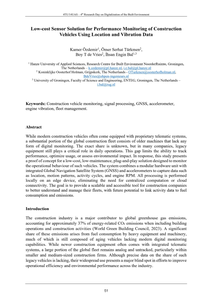While modern construction vehicles often come equipped with proprietary telematic systems, a substantial portion of the global construction fleet consists of older machines that lack any form of digital monitoring. The exact share is unknown, but in many companies, legacy equipment still plays a critical role in daily operations. This gap limits the ability to track performance, optimize usage, or assess environmental impact. In response, this study presents a proof of concept for a low-cost, low-maintenance, plug-and-play solution designed to monitor the operational behaviour of such vehicles. The system combines a modular hardware unit with integrated Global Navigation Satellite System (GNSS) and accelerometers to capture data such as location, motion patterns, activity cycles, and engine RPM. All processing is performed locally on an edge device, eliminating the need for centralized computation or cloud connectivity. The goal is to provide a scalable and accessible tool for construction companies to better understand and manage their fleets, with future potential to link activity data to fuel consumption and emissions.
DOCUMENT

Schepen in moeilijkheden op zee leveren vaak besluitvormingsproblemen op tussen de scheepseigenaar/kapitein en de kuststaat. Kuststaten en met name de lokale overheden willen een probleem schip graag zo ver mogelijk weg sturen van hun gebied terwijl de eigenaar/kapitein zijn schip graag zo snel mogelijk naar de kust, een beschutte locatie of haven wil brengen. Het onderzoek geeft onderbouwing voor de besluitvorming rond schepen in moeilijkheden, zowel voor de zeescheepvaart als de betrokken besluitvormers van oeverstaten. Het product van het project is: een, op uitgewerkte scenario’s per scheepstype en lading gebaseerde besluitvormingsprocedure voor zeeschepen in moeilijkheden
DOCUMENT

Climate change is one of the most critical global challenges nowadays. Increasing atmospheric CO2 concentration brought by anthropogenic emissions has been recognized as the primary driver of global warming. Therefore, currently, there is a strong demand within the chemical and chemical technology industry for systems that can covert, capture and reuse/recover CO2. Few examples can be seen in the literature: Hamelers et al (2013) presented systems that can use CO2 aqueous solutions to produce energy using electrochemical cells with porous electrodes; Legrand et al (2018) has proven that CDI can be used to capture CO2 without solvents; Shu et al (2020) have used electrochemical systems to desorb (recover) CO2 from an alkaline absorbent with low energy demand. Even though many efforts have been done, there is still demand for efficient and market-ready systems, especially related to solvent-free CO2 capturing systems. This project intends to assess a relatively efficient technology, with low-energy costs which can change the CO2 capturing market. This technology is called whorlpipe. The whorlpipe, developed by Viktor Schauberger, has shown already promising results in reducing the energy and CO2 emissions for water pumping. Recently, studies conducted by Wetsus and NHL Stenden (under submission), in combination with different companies (also members in this proposal) have shown that vortices like systems, like the Schauberger funnel, and thus “whorlpipe”, can be fluid dynamically represented using Taylor-Couette flows. This means that such systems have a strong tendency to form vortices like fluid-patterns close to their air-water interface. Such flow system drastically increase advection. Combined with their higher area to volume ratio, which increases diffusion, these systems can greatly enhance gas capturing (in liquids), and are, thus, a unique opportunity for CO2 uptake from the air, i.e. competing with systems like conventional scrubbers or bubble-based aeration.
In recent years, human-induced seismicity in the northern part of the Netherlands increased rendering the seismic response of unreinforced masonry (URM) structures critical. Majority of the existing buildings in the Netherlands are URM, which are not designed to withstand earthquakes. This issue motivates engineering and construction companies in the region to research on the seismic assessment of the existing structures.The companies working in the structural engineering field in the region were forced to adapt very quickly to the earthquake related problems, such as strengthening of existing buildings after earthquake. Such solutions are of prime importance for the Groningen region due to the extent of the earthquake problems and need for strengthening the houses. The research published in the literature show that the connections play an important role in seismic resistant of the houses. Fixing or improving the poor wall-to-wall or floor-to-wall connections may have a large positive impact on the overall seismic behaviour. Some strengthening solutions are already provided by SMEs, and an extensive experimental campaign was carried out at TU Delft on retrofitted connections. In this project, a new experiment will be run on a large shake-table, unique in the Netherlands, that can simulate earthquake vibrations. These tests, together with the previous experience, will complement the overall knowledge on the strengthening solutions and their performance under real-time actual earthquake vibrations.
In recent years, human-induced seismicity in the northern part of the Netherlands increased rendering the seismic response of unreinforced masonry (URM) structures critical. Majority of the existing buildings in the Netherlands are URM, which are not designed to withstand earthquakes. This issue motivates engineering and construction companies in the region to research on the seismic assessment of the existing structures. The companies working in the structural engineering field in the region were forced to adapt very quickly to the earthquake related problems, such as strengthening of existing buildings after earthquake. Such solutions are of prime importance for the Groningen region due to the extent of the earthquake problems and need for strengthening the houses. The research published in the literature show that the connections play an important role in seismic resistant of the houses. Fixing or improving the poor wall-to-wall or floor-to-wall connections may have a large positive impact on the overall seismic behaviour. Some strengthening solutions are already provided by SMEs, and an extensive experimental campaign was carried out at TU Delft on retrofitted connections. In this project, a new experiment will be run on a large shake-table, unique in the Netherlands, that can simulate earthquake vibrations. These tests, together with the previous experience, will complement the overall knowledge on the strengthening solutions and their performance under real-time actual earthquake vibrations.